Lindsay Townsend's Blog, page 28
May 3, 2010
Love and magic in the Middle Ages
 Imagine you're a young medieval lady and a young man creeps up, whacks you three times over the head with a hazel stick inscribed with the magical incantation pax+pix+abyra+syth+samasic and tries to kiss you. It sounds a touch desperate these days, but in the Middle Ages this was seriously suggested as a way for a man to get a woman to fall in love with him.
Imagine you're a young medieval lady and a young man creeps up, whacks you three times over the head with a hazel stick inscribed with the magical incantation pax+pix+abyra+syth+samasic and tries to kiss you. It sounds a touch desperate these days, but in the Middle Ages this was seriously suggested as a way for a man to get a woman to fall in love with him.Medieval lovers tried subtler ways, too - spells, charms, amulets and potions - to win the affections of those they desired, all in defia...
Published on May 03, 2010 06:12
April 29, 2010
'A Knight's Enchantment' gets four stars from Romantic Times
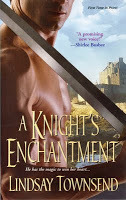 The first review of A Knight's Enchantment is in, from the June issue of Romantic Times, and it lifted my day:
The first review of A Knight's Enchantment is in, from the June issue of Romantic Times, and it lifted my day:'Townsend's newest book, with its back-drop of political and religious intrigue and mayhem, delivers a romance not soon to be forgotten. With characters of great depth and emotion, torn between familial responsibilities and their deepening love, this explosive tale will bring joy and fulfillment to readers.
'Joanna of Glastonbury, an alchemist, is forced to create gold for an elixir...
Published on April 29, 2010 00:36
April 26, 2010
RT nomination for 'A Knight's Captive'
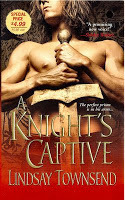 I'm delighted to say that A Knight's Captive was chosen among the select band of nominees for the Best Historical Novel category in the Romantic Times 2009 Reviewers' Choice Awards this month. I'm tickled pink to have been shortlisted, and congratulations to Tessa Dare, who won.
I'm delighted to say that A Knight's Captive was chosen among the select band of nominees for the Best Historical Novel category in the Romantic Times 2009 Reviewers' Choice Awards this month. I'm tickled pink to have been shortlisted, and congratulations to Tessa Dare, who won.The list of all the nominees and winners is here.
Published on April 26, 2010 11:01
April 16, 2010
'Secret Treasure' audiobook out today
 Audiolark have just released their audiobook of A Secret Treasure, so now my Greek island romantic mystery comes with the friendly, engaging voice of its reader, Melissa Malone. And all for $12.99....
Audiolark have just released their audiobook of A Secret Treasure, so now my Greek island romantic mystery comes with the friendly, engaging voice of its reader, Melissa Malone. And all for $12.99....
Published on April 16, 2010 09:15
April 7, 2010
Women and alchemy
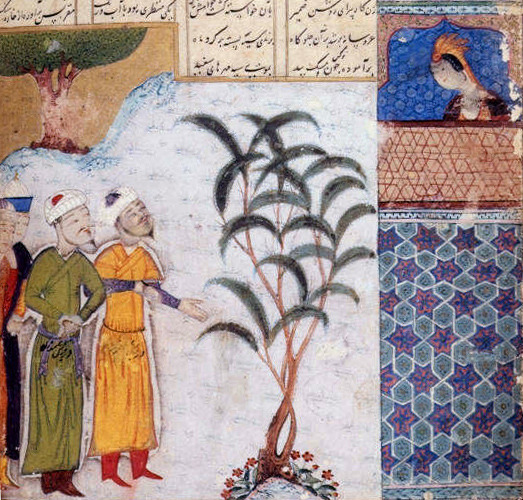 Everyone knows that alchemy is the art of turning base metals into gold. It was also seen as a pursuit of divine knowledge and immortality. From its very beginning in the ancient world, alchemy was seen either as a glorious search for truth or as a means for charlatans to hoodwink money out of gullible patrons. Such dabblers in the art were known unkindly as 'puffers' - from the bellows often used in alchemy in the heating of substances - and were despised by the more serious students of alch...
Everyone knows that alchemy is the art of turning base metals into gold. It was also seen as a pursuit of divine knowledge and immortality. From its very beginning in the ancient world, alchemy was seen either as a glorious search for truth or as a means for charlatans to hoodwink money out of gullible patrons. Such dabblers in the art were known unkindly as 'puffers' - from the bellows often used in alchemy in the heating of substances - and were despised by the more serious students of alch...
Published on April 07, 2010 00:00
March 31, 2010
Having a quiet Easter...
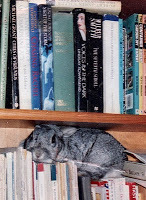 It's Easter Bunny time. Our model today is Smokey, a Netherland Dwarf, one of a long line of rabbits owned and cared for by my nephew Tom Underwood down in Devon.
It's Easter Bunny time. Our model today is Smokey, a Netherland Dwarf, one of a long line of rabbits owned and cared for by my nephew Tom Underwood down in Devon.Apart from being healthy, inquisitive and housetrained, Smokey clearly had immaculate taste in reading. On the top shelf are some of my English editions, including Chasing Rachel, which is coming out again this year in a download from Bookstrand.
 In fact, the edits for Chasing Rachel turned up this morning, so I know how I'm going to...
In fact, the edits for Chasing Rachel turned up this morning, so I know how I'm going to...
Published on March 31, 2010 05:00
March 30, 2010
Carols and capering: medieval dance
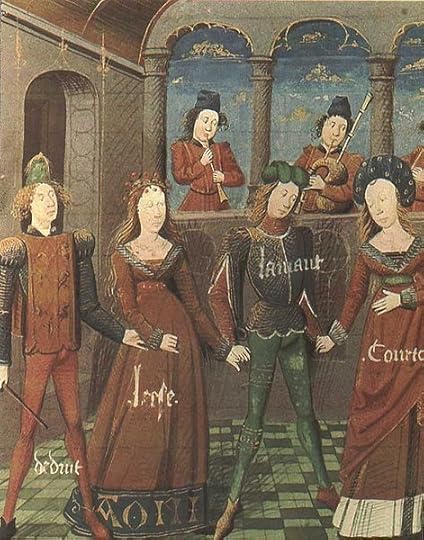 Four husbands into her career, Chaucer's Wife of Bath was still young and a lively soul, 'yong and ful of ragerie,/Stibourn and strong, and joly as a pie [magpie:]./How koulde I daunce to a harpe smale,/And singe, ywis, as any nightingale,/Whan I had dronke a draughte of sweete wyn!' So how would she have danced?
Four husbands into her career, Chaucer's Wife of Bath was still young and a lively soul, 'yong and ful of ragerie,/Stibourn and strong, and joly as a pie [magpie:]./How koulde I daunce to a harpe smale,/And singe, ywis, as any nightingale,/Whan I had dronke a draughte of sweete wyn!' So how would she have danced?Dancing in circles has gone on for who knows how long, and the medieval carol - a circular dance and the songs that went with it - was popular with everybody but the church. The songs,...
Published on March 30, 2010 08:15
Medieval dance
 Four husbands into her career, Chaucer's Wife of Bath was still young and a lively soul, 'yong and ful of ragerie,/Stibourn and strong, and joly as a pie [magpie:]./How koulde I daunce to a harpe smale,/And singe, ywis, as any nightingale,/Whan I had dronke a draughte of sweete wyn!' So how would she have danced?
Four husbands into her career, Chaucer's Wife of Bath was still young and a lively soul, 'yong and ful of ragerie,/Stibourn and strong, and joly as a pie [magpie:]./How koulde I daunce to a harpe smale,/And singe, ywis, as any nightingale,/Whan I had dronke a draughte of sweete wyn!' So how would she have danced?Dancing in circles has gone on for who knows how long, and the medieval carol - a circular dance and the songs that went with it - was popular with everybody but the church. The songs,...
Published on March 30, 2010 08:15
March 23, 2010
Prisoners in the castle: dungeons and oubliettes
 Medieval castles and dungeons tend to go together in people's imaginations and I have set important scenes in A Knight's Enchantment in a dungeon, where the heroine Joanna's father is being held. What we imagine as a typical dungeon, however - dark, underground, no windows, lots of chains - was less common in the Middle Ages than is assumed.
Medieval castles and dungeons tend to go together in people's imaginations and I have set important scenes in A Knight's Enchantment in a dungeon, where the heroine Joanna's father is being held. What we imagine as a typical dungeon, however - dark, underground, no windows, lots of chains - was less common in the Middle Ages than is assumed.Take the word 'dungeon'. Its earliest form, donjon, meant a keep or tower, a strong defensive position. Over time that tower has been taken to mean a pri...
Published on March 23, 2010 15:36
Not so enchanting: dungeons and oubliettes
 Medieval castles and dungeons tend to go together in people's imaginations and I have set important scenes in A Knight's Enchantment in a dungeon, where the heroine Joanna's father is being held. What we imagine as a typical dungeon, however - dark, underground, no windows, lots of chains - was less common in the Middle Ages than is assumed.
Medieval castles and dungeons tend to go together in people's imaginations and I have set important scenes in A Knight's Enchantment in a dungeon, where the heroine Joanna's father is being held. What we imagine as a typical dungeon, however - dark, underground, no windows, lots of chains - was less common in the Middle Ages than is assumed.Take the word 'dungeon'. Its earliest form, donjon, meant a keep or tower, a strong defensive position. Over time that tower has been taken to mean a pri...
Published on March 23, 2010 15:36



